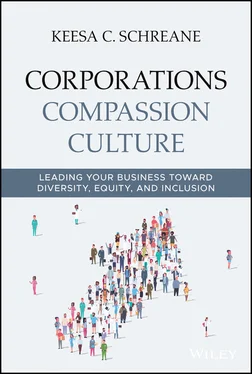These positive, compassionate examples are a start. But unless corporations and their leaders change how they do business and how they treat their most valuable resource—people—they will fail fast. They will not survive among the next generation of business leaders, who have an inherent leaning toward creativity that only happens when employees feel comfortable and supported. Creativity—instead of old-school, destructive competition—delivers innovation that not only leads to revenue generation but also supports a firm's longevity.
The first step toward building a compassionate culture, with equality and inclusion at its core, is making a commitment to putting people first. Here is what a people-first focus looks like:
Communicating how employees' jobs make a difference in society
Embracing diverse talent while exploring new markets
Creating a work culture in which employees exude enthusiasm, excite customers to patronize their firms, and advocate for their brands in their communities
Committing to doing their best to protect employees day-to-day and also in the event of a catastrophe
Offering employee incentives that drive company loyalty and real payoffs
What Is Compassion and Why Does It Matter?
Compassion in business means inspiring people to aim as high as they can in their conduct and their innovation each day. That can include basic kindness and cordial daily interaction between colleagues, but it goes a lot further than that. Compassion empowers people to be open—to replace fear of failure with faith in their abilities, learn from challenges, and construct creative approaches to business problems. A compassionate culture supports the mental, physical, and economic well-being of employees, as well as their professional growth, by governing with integrity and care that comes with positions of power.
Believe it or not, compassionate leadership is practical. When there is compassion in business, a culture of equality, inclusion, and kindness follows. People feel better about the work they do, leading to higher levels of productivity. They increase their sales and are more committed to their work.
Research finds compassion triggers brain activity associated with learning and reward in decision-making, as well as creating positivity and “kinder and more eager to help” attitudes. 11 Additionally, compassion is seeing a problem (or suffering) and responding to that problem in a way that includes “courage, tolerance, equanimity.” 12
This is exactly the type of activity successful businesses want to govern relationships with customers. They express a desire to help customers and serve them by solving customers' problems through products and services. They become obsessed with fulfilling the customer's specific need, while engaging with kindness to support customer retention.
This is also how successful corporations seek to engage with shareholders. They exhibit strong, thoughtful decision-making skills with the aim of serving (helping) their interests by providing solutions to increase profitability in business.
Seeing compassion through the lens of serving others and solving problems clarifies how compassion relates to a company's relationships with customers and shareholders.
Seeing compassion through this same lens can also offer insight into how corporate leaders should aspire to serve their employees. This aspiration to serve employees should exist for all management levels, from frontline supervisors to CEOs. Learning, decision-making, equanimity, and tolerance are all ways companies can express their focus on people through compassion toward their employees.
Inclusiveness and equality reflect a leader's courage to think differently from society or even from the old business culture that has conditioned that person. Inclusiveness and equality require less focus on self and more focus on understanding others; less emphasis on the type of competition that has destructive qualities and more emphasis on cooperation that creates a legitimate partnership with everyone in the business ecosystem, including employees.
This may sound theoretical, but there are practical ways this plays out in real, day-to-day corporate leadership. Each employee and stakeholder, regardless of their title, has agency to choose how to act toward colleagues. Compassionate business leaders know that decisions they make in the boardroom, including decisions they make on behalf of the organization, can significantly affect not only individual employees and customers but also families and wider communities. Leaders who understand compassion will support their employees' mental and physical well-being with fair pay, equal treatment, and ensuring that the company's behaviors and language foster innovation to support the enterprise and each employee in it.
Compassionate business leadership includes making thoughtful, courageous decisions in especially challenging environments. This is done by looking for creative solutions, seeking counsel and expertise from others, and seeing beyond traditional answers. When corporate heads lead with compassion, their employees, suppliers, and communities willingly support that leadership. Employees and others bring higher degrees of creativity to support business growth. This perspective also gives insight into why some businesses don't see this type of commitment from employees. It is because in inequitable environments, where behaviors such as microaggression and destructive competition flourish, the culture isn't conducive to employee comfort and the creativity needed to innovate. Resisting the courageous, compassionate form of leadership is why the old corporate culture is steadily self-destructing.
Old corporate culture has presented an especially difficult situation for many members of historically underrepresented—not to mention underestimated—demographics. Alleged “pipeline” issues—claims that it is not possible to find enough qualified people of color and women for certain positions—perpetuate underrepresentation in the workplace. Abysmal underrepresentation in C-suite positions, especially for Black women, shows corporate leadership continues to underestimate the leadership abilities of this demographic. As of the second quarter of 2020, only two Black women have ever led Fortune 500 companies, Ursula Burns of Xerox and Mary Winston of Bed, Bath & Beyond.
The demands for racial justice, employee equality, and improvements to the post-COVID-19 workplace are driving change in how business is done and whom business is done with. Yet, too many executives are still clinging to outdated ways to govern and lead. This is demonstrated by the numbers of unhappy employees and purpose-starved corporate cultures.
Business has always been the driver of innovation and economy in the world. So what happened? Looking at the big picture, most working adults with a bit of historical perspective agree things are better than they were a hundred years ago. Working conditions are safer and better regulated on the whole. Violence and discrimination toward people of color in places of work and exclusionary practices based on gender and ethnicity are no longer legal (albeit at times acceptable ).
Given all that progress, how did we get to a place where strikes, walkouts, inequality, low wages, discriminatory practices, debilitating stress, and lack of pay parity became all too familiar? Part of it has to do with the nature of the actions against employees. Some would say that microaggressions have now replaced deliberate discriminatory and violent behaviors. And all microaggressions are not illegal, so they have not been regulated out of business. (More about this specific behavior in Chapter 2.)
The best firms continually expend resources, intelligence, and time listening to others to understand how to create a fairer, more just culture. The best leaders root out potential threats to employee well-being. These leaders recognize threatening behaviors, including exclusion, inappropriate language, and unequal treatment, may sometimes be legal but are still unacceptable . These leaders have a choice between adjusting the existing culture and building a new foundation from the ground up. This choice is daunting.
Читать дальше












